Wasmer Art Gallery
Faculty Mentor, Mary Sullivan Voytek
December 5 - December 13, 2013
-
Angie Cruz WHO AM I?
Toggle More Info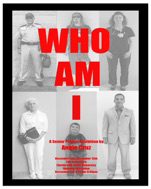
Stereotypes are a widely held but fixed and oversimplified image or idea of a particular type of person. It’s human nature to automatically place preconceived ideas, whether they negative or positive, on to someone upon initial interaction. It is easiest to respond with negative comments then something positive. Influences can make the public have stereotypical reactions towards a person’s skin tone, dress, and are often formed by social media, music, movies, television shows advertising and the list just goes on. There really isn’t a reason behind why society thinks the way they do when everyone may have a different outlook on things, but instead they think the way they do because it is what they were accustomed to. People have the power to change their mindset of others in a positive way and they can forget the negative thoughts that come to their minds and make this world into a better place for everyone.
Initially the focus for my senior project was on the stereotypes associated with Fraternity and Sorority Life but upon further research I realized that stereotypes are a broader and pervasive issue in the world. My intention is to create a series of art works that allows the viewers to confront their own stereotypical ideas and I want people to realize that the stereotypes they put on strangers are socially conditions, not always accurate and are often negative. We, as a society, have learned to judge people, from our family members, coworkers, to even our closest friends. Personally, people that don’t know me because of my association with Greek Life, my skin tone and my name, which has Hispanic roots, have stereotyped me. Unfortunately, we are all programmed to categorize people we don’t know so we know how to interact with them. It’s a major issue in today’s world because if people never judged one another on appearance and actually got to know them for whom they were, they would be shockingly surprised of the relationship they could build. Personally, I pride myself on not judging people by their outside appearance but this is something I have struggled with and had to make a huge effort to learn how to do. I want my project to raise awareness and understand that this may be an uncomfortable experience for some of my viewers but I want emotions to be struck and make them aware of the stereotyping they may be doing of people just on their outside appearance.
I chose photography as my artistic medium because I was able to capture the different stereotypes that people are so easily to judge. I have identified and photographed 6 subjects and each represents a different stereotype. I decided to use a Nikon D3100 with a 50mm lens to shoot my different subjects because the 50 mm lens is known to represent what the human eye sees normally. After taking the photos, I uploaded my photo into Photoshop converted to them black and white and to make sure all the details are still seen. The 6 images are 20”x60” because I wanted the subjects to be life size. The only color in my project is the red writing on the walls that spontaneously contributed by the viewers. This is an interactive art piece and I encourage the viewers to write on the walls using the red watercolor markers under the statement “Please write the first word that come to your mind”. The subjects I picked are from all over parts of Florida and I specifically avoided using subjects from the FGCU community or the close surroundings area. Please participate and write your initial thoughts of these strangers, the subjects will never know anything you have written about them.
-
Cam DeMay REBRANDED
Toggle More Info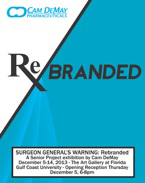
Can advertising and packaging change public perception, even when the substances have stigmas attached to them? Yes, I believe packaging and advertising can create a perceived added value to these substances. These works are intended to create a dialogue about the use of illegal drugs, legal drugs, and the addictions that trouble them both, in order to ask if any of them, when not abused, can have positive effects on one’s well being. I am accomplishing this by packaging illegal drugs in a familiar, recognizable way. Companies use advertising and packaging design to promote an illusion of well-being, and to control their message in order to generate a “need” or want for any product. We promote the use of legal drugs such as alcohol that has no ingestive medical purposes but has serious negative effects on the body and society; yet condemn people who smoke marijuana to alleviate pain from terminal illnesses. Advertising has convinced our culture that the more we have the better we will feel, just as the stereotypical drug-pusher on the corner sells the same idea.
I am working toward becoming a commercial graphic designer in the field of advertising. Though I have qualms about the ethics of capitalism and mass consumerism, I will inevitably face ethical questions in my career. I chose the topic of illegal drugs because there are so many taboos attached to them. All of them are deemed dangerous and illegal by our Federal Government, though in my opinion not all are medicinally or recreationally hazardous. Through personal experience I have seen the positive and negative effects drugs have had on one’s well being, while at the same time seen the same effects with legal products. Drug abuse is a serious issue, but it is certainly not limited to illegal drugs. In 2008 alone, there were 14,800 prescription drug based overdose deaths, that is more than heroin and cocaine combined (cdc). I want to re-brand and market these drugs in a professional way to see what conclusions people come up with.
Welcome to Cam DeMay Pharmaceuticals. My exhibit is a simulation of a pharmaceutical trade show booth that promotes the sale and use of my products. I have created a series of 8 drug packages and accompanying 22” x 16” print advertisements that promote the sale and use of drugs. Each drug is branded with a meaningful name and logo. I designed die-cut packaging to resemble the aesthetics of over-the-counter medical products that are a part of everyday life. These packages include stylized graphics to promote value of each product. Each package promotes medicinal qualities that the drug may have and that are similar to existing advertised products. The print advertising is a mash up of direct-to-consumer pharmaceutical print advertisements and over-the-counter drug print advertisements. They include the branded logos, graphics, purposes, and side effects. If you have any questions, please feel free to ask my sales representative and they will make sure to fit you with our most effective drug.
-
Andrea Dickinson BEAUTIFUL DISASTERS
Toggle More Info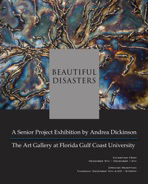
Finding beauty in disaster might be a difficult idea to grasp sometimes, but I believe it is possible. My Senior Project explores different natural disasters and the hidden beauty behind their power. Natural disasters affect more than 450 million people each year, leaving many people without homes and an estimated 100 billion dollars of damages. These events have an uncanny ability to change the face of the earth in catastrophic ways. Many Floridians have felt the power behind these disasters and it is both incredible and humbling. Through my work I explore different lines, textures, and patterns that these events leave in their wake. By looking at natural disasters, such as hurricanes, earthquakes, and volcanoes from a different perspective, I abstract and illustrate what I believe makes them beautiful and powerful.
For the majority of my life, nature has played an important role in my work. I have always been fascinated by patterns in nature, such as the imperfections in a leaf or broken shards of shells on the beach. More recently I have become particularly interested in the disruptions of these normal patterns. Through my project, I began to focus on the extreme disruptions in nature, such as natural disasters. Each unique shape and texture I found in these disruptions also seemed to convey a sense of power and strength. Focusing on the chaos and intensity of energy behind the disasters was important to me, and in turn became one of the main concepts in my Senior Project. Each piece that I made for the project reflects a different natural disaster and its various levels of power.
I enjoy working with metal and for this specific project I believe this material also helped reinforce the strength behind the natural disasters. To create my pieces, I used several different sizes of steel and stainless steel between the ranges of 14 to 24 gauges. Using an assortment of tools, such as a grinder and plasma torch, I cut each piece accordingly. The plasma torch was extremely helpful and gave me a precise and vivid edge on several of my sculptures. Using the MIG welder, I assembled and textured the pieces. Different textured grinding wheels gave me the ability to create swirls and lines on the metal that would have been hard to do otherwise. Adding heat and acrylic paint to some of the sculptures helped me bring out the metal’s natural colors. The final process for the steel pieces was adding a powdered-coat to prevent rusting and oxidation. Through each process, the pieces were able to develop a new characteristic that helped them better relate to their intended natural disaster.
-
Roxanne DuBois WINGS OVER WYOMING
Toggle More Info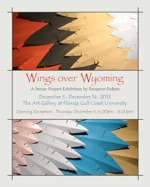
In the Fall of 1998 Matthew Shepard was severely beaten while tied to a fence in the middle of nowhere and then left for dead. His death caused uproar among the Laramie Wyoming community, where it took place, and around the world. Following the event, controversy surrounded the small town of Laramie, where in the years to come there would be much debate about what happened to Matthew and what should be done to the boys that did this to him. Among the interviews that took place in Laramie were those of the members of the theatre group that called themselves the Tectonic Theatre Project. They had set out to create a play based on what had happened to Matthew to raise awareness for this extremely common occurrence that all too often goes unnoticed. The people that were interviewed had all different opinions about what happened, some blamed Matthew for what happened to him, that his sinful lifestyle brought it upon him. Others were angry that something like this could happen in a close nit town like Laramie. One of the individuals that was angry was Romaine Patterson, a close friend of Matthew. In her interviews she recalls the anti-gay protesters from the Westboro Baptist Church at the trial of both of the boys who murdered Matthew, they were there condemning Matthew for his ungodly choice in lifestyle. As you can imagine it was quite upsetting to the family to see this, so Patterson gathered a group of friends of Matthew and fellow activists and organized something they called “Angel Action.”
According to her interview this group, all dressed as angels with huge wings, gathered right in front of the Westboro Baptist Church protesters and shielded their hateful slurs from reaching the family and friends that had gathered at the courthouse in support of Matthew. The wings that I have created are meant to represent the ones worn by the activists those fateful days in Laramie. My career goal as an artist is to create prop pieces to be used in theatre or film. These wings will be used in the upcoming performance of The Laramie Project that will be showing here at Florida Gulf Coast University in the Spring 2014 semester. The umbrellas seen hanging overhead are used in a scene from the play that takes place during Matthew’s funeral. I thought that the use of lace would create dramatic lighting and add a more somber look to the scene and my installation. I have been working closely with my client, Michelle Hayford the director of the Laramie Project, in order to achieve her desired product for these wings and umbrellas. Through several meetings we were able to make concise, mutual decisions on all aspects of my project.
I had initially planned on making traditional wings with real feathers, but after much research and experimentation I found that that wouldn’t be very interesting or unique. While doing research on other artist’s versions of wings I found several that were making them out of paper, this inspired my final decision to create paper wings. The feathers are cut out of thick cardstock and poster board then spray painted the different colors, each feather is cut out individually and every single one is unique. The feathers were then glued to cardboard pieces in layers in order to achieve depth. Between two of the central cardboard pieces is a space that has been cut out so that the supporting structure can slide in and attach to the wall and eventually a harness to be worn by the actors in the upcoming performances. The umbrellas were stripped of their colorful fabric and replaced by thick black lace. I hung them from the ceiling in a cascading formation in order to dilute the gallery light and create a more dramatic experience for my installation.
-
Hadar Frey BEYOND THE SURFACE
Toggle More Info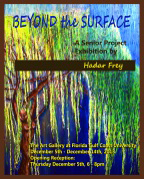
My show is inspired by a combination of the Surrealist style and my interpretation of the Celtic’s beliefs. Surrealism is a way to bring different symbols together from the conscious and unconscious mind in a complete way so that the world of dream and fantasy can be joined. Many of the surrealist artists often use different symbolism to convey a message or an idea; Dali was driven from his subconscious and Magritte was using symbols from his personal life. Celtic people had a sacred belief in trees and they saw them as ancestors of humans. The most sacred of trees (center of their communities), were the Oak and the Ash, both of which were believed to possess the special qualities required for The Tree of Life. The Celts believed that its branches reached toward heaven, the trunk was the connection to the physical world, and the roots were doorways to the underworld. They also had an entire tree-belief-system, where each tree was believed to possess special qualities.
The Surrealist style has long been a part of my work and I have consistently used different symbols to reflect my reality. An example is the tree of life; it is a strong and important symbol in my belief system. I have recreated in many different ways my most commonly used symbols of the woman’s figure and trees. In each work I have made a connection between the woman’s figure and the tree. I often find myself wondering why I keep creating these images and if there might be hidden meaning behind it. In exploring these topics, I found a common denominator in the Celtic’s ideas and my own. I started to see my obsession with my most common symbols as something that can be explained in a very spiritual way. I can now see more clearly this strong connection that exists between trees and humans as being the foundation of my work. My show is inspired by the Celtic belief system and uses their ideas and symbols while adding my own personal take on them. My works hold the characteristics of the Surrealistic style, and they have different repetitive symbols that come together to tell a story. They combine ancient ideas with my own ideas and create something new and beautiful out of them. Each painting gives the viewer the opportunity to look beyond the surface and see something introspective.
My show consists of 4 large-scale paintings, each incorporating a tree as a main focal point in the composition. By creating large-scale paintings I intended to give the viewer the feeling of looking at a real tree. Under each painting there is a short explanation regarding the meaning of each specific tree within the Celtic’s beliefs. My vision is that each viewer will look at my work and see the connection between my ideas and the Celtic’s ideas. My aim is that viewers will immerse themselves in the world that I have created. I have placed the paintings in a dark, closed-in space to allow the viewers to focus more clearly. The spiritual aspect of the works is achieved by the use of mystic colors within the dark space and the softly playing Celtic music. In each painting there is a tree with a hidden figure that has been created with the Celtic’s beliefs in mind. I used original pictures of each tree to study the shapes and colors in order to paint them with a natural and realistic connection. To this organic form of each tree I added my own vision that incorporates the Celtic belief of each tree. One painting is focused on the tree of life concept and the other three paintings are focused on the qualities that fit my personality the best from within the Celtic tree-belief system.
-
Frank Gumpert REPULSION TO REVERENCE
Toggle More Info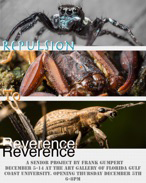
Repulsion to Reverence is a body of work that ultimately conveys the overlook of some of the world’s smallest life, also known as insects. The title for this exhibition explains how we generally interact with insects on a daily basis. We avoid insects, sometimes taking it to the extreme without even knowing what the insect is. Repulsion to Reverence will bring awareness to our human to insect interaction through allowing the viewer to observe insects in a larger than life image. By removing the physical insect and replacing it with an approachable photograph the viewer will be able to observe and admire the insect for what it really is. Making the images as large as I can possibly create I hope to make the viewer aware of the intricacy and beauty of the micro world around us.
Being a macro photographer has had profound impacts on me as an individual. I have come to understand the intimate beauty that life can have on such a tiny level. Once you watch a bark scorpion fight off a brown anole, or watch a dragon fly hunt, suddenly homosapien life seems less complicated. In our daily life we tend to tune out and focus on the bigger picture. With the constant distraction and hum of the world we often avoid, ignore, and step on, some of the most complex and bizarre creatures our planet has to offer. The ultimate intention of this body of work is to hopefully restore some conscious respect for our smallest neighbors. I want the viewers to feel a connection to the insects themselves. I want viewers to be aware of their surroundings and come to terms that humans are not the only ones in it. Most importantly I want viewers to come away with a better sense of the beauty of nature right down to the smallest of life.
The process for taking photographs of such small creatures is very complicated and takes patience. Not all insects are willing to pose long enough for a shot and even when they do it takes a steady hand and technical know how to capture a usable image. I first assemble what I call my “rig”. It is essentially a camera, a lens, an off camera flash, a soft box, and a macro arm rig. The entire assembly weights around 14 pounds depending on the setup. The lens I primarily use is the Canon Mp-e. The Mp-e is a unique lens designed exclusively for macro shooting. It is a fixed focus lens, which means the lens is focused by moving the entire rig forwards and backwards. At a focusing distance of two inches you can imagine most bugs do not like to let you get that close, but a patient hand and an understanding of insect behavior has led me to capture the images I have on display today. The images are printed of Kodak metallic paper and the frames are die cut polished aluminum.
-
Kelli Harris: AGAPE
Toggle More Info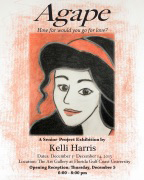
Greek mythology is a set of myths, legends, and teachings that were created by the ancient Greeks. Using gods, goddesses, monsters, and heroes in epic tales and adventures, the Greeks used this mythology to form their beliefs and views of the world around them. They explained the creation of the world, the daily actions of life, and the afterlife. The myths also served as lessons to teach people important ideals and social behaviors. Historically, Greek mythology has influenced the basis for many works of art and literature. Today, unfortunately, Greeks myths have been resigned to the role of storytelling revealing the life and times of the ancient Greeks. I believe the underlying themes and lessons of the myths are timeless, and deserve more attention by the audiences of today.
Throughout time, Greek mythology has always fascinated me. The stories of gods and their interactions with humans are vastly entertaining, and I’ve always identified valuable lessons about being humble, brave, and honest in the tales. I have always been attracted to artwork that has underlying meanings, and moves the viewer toward new awarenesses. It is my intention to take a classical Greek myth, and with modern technology and social contexts reintroduce it to a modern audience. I chose a motion book as the medium for my senior project. The art of ancient Greece has always been an area of interest for me, and I took the use of line and color to incorporate into the book. The installation shows the beginning of the story, and the accompanying drawings on the walls surrounding the display hold glimpses into subsequent chapters of the story hopefully enticing the viewer to be eager for more.
Combining Greek mythology and contemporary digital media for my senior project felt natural and exciting. I used the skills I have developed over the years in drawing to create the visuals for the motion book by hand using charcoal. I then brought the images into the computer, and arranged them in Photoshop into what would be the final page layout. I would then bring the file into Flash, and use the program to create the animations and interactive components of the book. I created a modern setting, translated the characters into modern day people, and gave them the personalities and thinking of today’s society. The drawings on the walls surrounding the installation are also done in charcoal, and are meant to give the viewer a taste of what is to come next in the story.
-
Taylor Ann McGuire: GROTHOR AND JENNET: ARMORED CHAMPIONS
Toggle More Info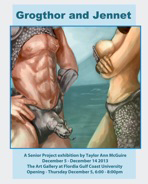
Finding beauty in disaster might be a difficult idea to grasp sometimes, but I believe it is possible. My Senior Project explores different natural disasters and the hidden beauty behind their power. Natural disasters affect more than 450 million people each year, leaving many people without homes and an estimated 100 billion dollars of damages. These events have an uncanny ability to change the face of the earth in catastrophic ways. Many Floridians have felt the power behind these disasters and it is both incredible and humbling. Through my work I explore different lines, textures, and patterns that these events leave in their wake. By looking at natural disasters, such as hurricanes, earthquakes, and volcanoes from a different perspective, I abstract and illustrate what I believe makes them beautiful and powerful.
For the majority of my life, nature has played an important role in my work. I have always been fascinated by patterns in nature, such as the imperfections in a leaf or broken shards of shells on the beach. More recently I have become particularly interested in the disruptions of these normal patterns. Through my project, I began to focus on the extreme disruptions in nature, such as natural disasters. Each unique shape and texture I found in these disruptions also seemed to convey a sense of power and strength. Focusing on the chaos and intensity of energy behind the disasters was important to me, and in turn became one of the main concepts in my Senior Project. Each piece that I made for the project reflects a different natural disaster and its various levels of power.
I enjoy working with metal and for this specific project I believe this material also helped reinforce the strength behind the natural disasters. To create my pieces, I used several different sizes of steel and stainless steel between the ranges of 14 to 24 gauges. Using an assortment of tools, such as a grinder and plasma torch, I cut each piece accordingly. The plasma torch was extremely helpful and gave me a precise and vivid edge on several of my sculptures. Using the MIG welder, I assembled and textured the pieces. Different textured grinding wheels gave me the ability to create swirls and lines on the metal that would have been hard to do otherwise. Adding heat and acrylic paint to some of the sculptures helped me bring out the metal’s natural colors. The final process for the steel pieces was adding a powdered-coat to prevent rusting and oxidation. Through each process, the pieces were able to develop a new characteristic that helped them better relate to their intended natural disaster.
-
Sarah Neat DAMAGED
Toggle More Info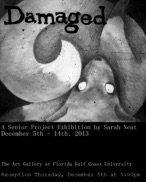
Post Traumatic Stress Disorder (PTSD) is psychiatric in nature. Typically PTSD is a result of witnessing, or bring a part of, a traumatic event, including anything from natural disasters, war, participating in combat, incidents of terrorism, sudden and critical accidents, physical assault, mental abuse, or sexual assault. Post Traumatic Stress Disorder is a stress reaction that does not go away over time, where most survivors of trauma will return to normal living and behaviors given some time. These prolonged and growing stressors result in PTSD. My own experience with PTSD has been highly personal – specifically from abuse by a step-parent during my childhood, and domestic abuse from a past relationship. My PTSD has included symptoms of feeling detached, feelings of isolation, extreme depression and the desire to die, thoughts of suicide, angry outbursts due to short temper, avoidance, jumpiness and paranoia due to hyper-awareness, self-mutilation, poor self-esteem, night terrors and frequent nightmares, OCD, social anxiety and extreme timidity, panic and anxiety attacks, and multiple flashbacks simply by minor triggers. I had only recently discovered that I had PTSD, and sought help through counseling. My symptoms slowly began improving, and the therapy helped some minor symptoms to disappear altogether.
Being that my chosen subject is quite macabre in itself, though expressive in nature, I chose to display each emotion through the use of graphite and charcoal on paper or matting board. Some artists of disturbing art genres choose to work with color to emphasize gore, but I had felt that color would actually inhibit the necessary projection of the emotions I wished to portray. Multiple sized drawings were created in order to further the chaotic atmosphere. Various and extensive emotions and experiences will be illustrated, including depression, desolation, despair, rage, exhaustion, frustration, confusion, and many more intricate feelings of myself, a PTSD victim. Throughout the entire installation, I have pinned up black string in varying lengths representing the numerous repetitive lines it has taken to create the artwork. The string also serves to echo the trails that tears make when one has been crying from the suffering that occurs when trauma is involved.
My artwork stems from the misunderstanding by family and friends of my PTSD symptoms, and I seek to invoke my own inner emotions and endurance of my disorder through the use of an anthropomorphic cartoon character which represents me. I then express the symptoms and processes through my drawing skills, hoping to sufficiently translate these complex emotions to those who otherwise would not understand, to meet in a sort of mutual understanding, a moment of learning for those who are outside looking in. To draw these artworks has been a therapy in and of itself for me as the artist, but I would hope that the therapy would not stop at my own psyche. I liken the art I have created to a song on the radio one listens to when they feel the same way the singer describes – to look at my works, I wish for the viewer to think to themselves “this... I've felt this way before,” I want the viewer to know that they are not alone in their own dreary or dismal situation. We have all endured our own pains and tortures which traumatize each person differently. The idea behind these ghastly images is not to shock and terrorize the viewer, but to allow the viewer a crack in the blinds in which they can glimpse what it is to be a survivor of trauma and a sufferer of Post Traumatic Stress Disorder.
-
Anthony Watson THE EXISTENTIAL CONDITION OF MAN: OTHERNESS
Toggle More Info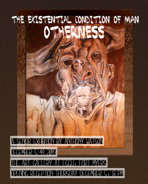
The concept explored revolves around the intriguing phenomena of social alienation. Social alienation generally speaking, is when one is estranged from other people. There is a perceived and experienced sense of otherness and this creates a divide between the two. The result is that they become less able to relate to one another and alienation occurs. Members of a social group can potentially ostracize others whose personality types are too dissimilar to their own. A person can withdraw also from others because of frustrations, arising from not being able to establish stable interpersonal relationships. This can further reinforce alienation by seeing such potential conflict occur with the self, and thus the self estranges itself from its own sense of awareness. The lack of being able to self-actualize is the cause of this inner conflict. Social alienation can occur between class divisions, individuals, and social groups. It can even occur between political figures and their constituents.
These ideas are relevant to me because I identify with social alienation as a state of being. My childhood was fraught with having trouble connecting with others and creating interpersonal relationships. I was not accepted by many my own age because they perceived me as dissimilar and therefore they viewed me as an oddball. This caused quite a bit of grief in my life and I became alienated by my peers. The pieces I have made embody my frustrations, my sorrows, and my sense of separateness because of how I was treated. Through introspection, research and inference, I realized just how broadly social alienation can apply and that many can be alienated in all sorts of circumstances. Therefore, I have made the figures in my pieces represent series of states that everyone can relate to. Therefore, the viewer imposes their own experiences onto the meaning of the piece through personal interpretation. In this way, the pieces act as mirror reflections of the onlooker. I believe that by this process these works will evoke a sense of empathy within the heart of the viewer, as s/he considers the implications of the piece and his/her interpretation of it.
My collective body of work primarily incorporates mixed media, including wood as a primary medium of expression. Part of my series consists of wood panels with portraits and full body figures burned onto the surface. This was achieved by using a wood burner, with a heated metal tip that darkens the burn, when in contact with the surface. In addition I’ve used white wax china marker pencil, white conte crayon, and graphite for the shadows and highlights. The wood’s roughhewn surface was ideal for the figures I depicted, as it represented the rough state of the marginalized person’s psyche. The contrast in the grain brings one’s attention to the texture of the surface and makes the roughness of the wood all the more apparent. The other half of the series consists of wood cut prints that I created through carving wooden templates and then pressing these templates onto rag paper. The prints were printed on rag paper in black and white, as the contrast brings attention to the details of the figures facial features. The color is chosen precisely because it sets the mood, as the theme of my exhibition is a dark one. My reason for including prints in my series was because of German Expressionism’s profound influence on the conceptual and compositional elements of my pieces. Therefore these elements are integral to the meaning of each individual work.
-
Kim Marhoefer Willis SKIMMING THE SURFACE
Toggle More Info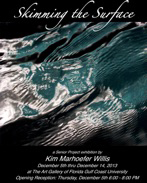
Familiar scenes from nature encourage us to feel connected to our surroundings. Throughout history, landscape painters have helped connect viewers to the environment. Artists can be masters of illusion, and some trompe l'oeil* painters are so skilled that they can momentarily fool you into thinking you are seeing an actual landscape. Once you spend a little time gathering more visual information, the picture becomes clear and you realize your original perception was inaccurate. Perception can be inaccurate. It can also be the foundation of many of the decisions we make. People base their decisions on both intuition and deliberative thinking, each in varied degrees. Studies have shown how people will defer more to intuition when pressured by time. As the information age places more pressures on our daily schedules, it stands to reason that we may rely more often on first perceptions and intuition when making critical decisions. As with the trompe l'oeil paintings, our perceptions about the environment may also be inaccurate. The grass is green. The sky is blue. All appears in order. Or is it? My landscapes are intended to celebrate our environment, and remind viewers that what we see on the surface may not always be the complete picture. My project examines the relationship between time and perception. My landscape prints demonstrate that our perceptions are developed as fully as the time we invest in them.
I have created two identical images, only different in their coloration. One image is sepia-toned; one image is in color. The sepia image may inspire a feeling of nostalgia, based on the perception we have developed for sepia images from the early days of photography. The color of the other image is arbitrary, and may inspire a variety of spontaneous perceptions based on personal choice. As you spend time with the prints you acquire information to enhance your perception. The label gives you information about the title, size and materials used. You will see the materials used for the sepia tone images. Suddenly, your perceptions may change. The sepia image may no longer seem nostalgic. It may now seem to be an environmental statement. Without having invested the necessary time, you would only be skimming the surface of the concept; you would not have recognized the material as the message.
The materials for this project are an essential part of the concept. As a printmaker I am able to make multiples of the same image. This duplication provides an easy side-by-side comparison. The contrast of images and materials symbolize the options we all have available in our daily interactions our environment. My landscape images are taken from photographs. I carefully choose compelling elements from many different photos, which I then bring together in the final compositions. I used Solar plates to create my final prints. The Solar plate process utilizes the sun’s light to transfer my image to the printing plate. Traditional etching processes, which use acids, are typically hazardous to the environment. My pigments, one environmentally friendly, one not, were chosen to highlight the disparity between stewardship and complacency. The images are inked in relief and intaglio methods, and are printed on 100% cotton rag paper.
* trompe l'oeil
ˌtrômp ˈloi/
noun
1.visual illusion in art, esp. as used to trick the eye into perceiving a painted detail as a three-dimensional object.
